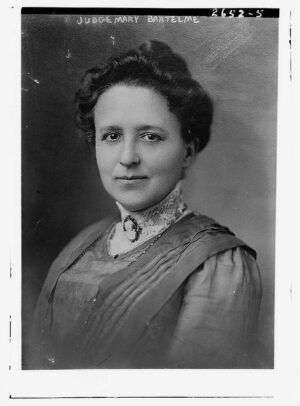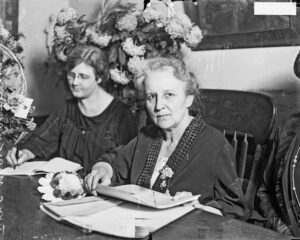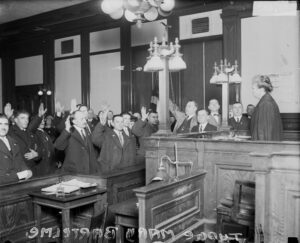Mary Margaret Bartelme was the first woman judge in Illinois. In this blog post, learn about how she devoted her life to reforming the treatment of young people in the juvenile court system.
“There are no bad children. There are confused, neglected, love-starved, and resentful children, and what they need most I try to give them—understanding and a fresh start in the right direction.”

Mary Bartelme, Chicago, c. 1910–15. Library of Congress, Bain News Service photograph collection, LC-B2-2652-5
On July 24, 1866, Mary Margaret Bartelme was born in Chicago near Fulton and Halsted Streets to immigrants Balthasar and Jeannette, who hailed from what is now modern-day Germany. Along with her two sisters and brother, she grew up in the area that is now Fulton Market. Bartelme graduated from West Division High School (now Chicago Bulls College Prep) at age 16 and attended Cook County Normal School (now Chicago State University), from which she graduated at age 19. Afterward, Bartelme began to teach at Armour Street and Garfield Park schools.
Bartelme originally had her sights on medical school. However, she had a change of heart after meeting Myra Bradwell, who was the first woman to pass the Illinois bar exam but was denied a law license because she was married. Bradwell went on to publish a successful law journal—Chicago Legal News—and found lawmakers to support legislation she drafted, such as the first law prohibiting employment discrimination.
Two decades after the first American woman earned a law degree, Bartelme enrolled in law school at Northwestern University in 1892, specializing in probate and real estate law. After graduating, she was admitted to the Illinois bar in 1894.
Bartelme was an active women’s club member. She cofounded the Chicago Business Woman’s Club in 1894 and was a member of the Chicago Suffrage Club, Chicago Women’s Club, the Cordon Club, the League of Women Voters, and more.
In 1897, Illinois governor John R. Tanner appointed Bartelme to be Public Guardian of Cook County. She was the first woman to occupy this position, which she held for 16 years. Two years later, along with Julia Lathrop, Lucy Flowers, the State Board of Charities, and other reformers, Bartelme lobbied for and established America’s first juvenile court in Chicago in 1899. That year, with Louise DeKoven Bowen and Sara Hart, Bartelme established a detention home instead of adult jail for juvenile offenders.
Bartelme resigned from her position as public guardian in 1913 to become assistant judge to Judge Merritt W. Pinckney who presided over a growing number of juvenile court cases; Hull-House founder Jane Addams had recommended Bartelme for this position. During her tenure, Bartelme gave girls in the juvenile court system the opportunity to appear before a woman judge for this first time.

Portrait of Judge Mary M. Bartelme of the Cook County Juvenile Court in a Chicago court room, January 1924. DN-0076674, Chicago Daily News collection, CHM
A year after her assistant judge appointment, Bartelme donated her own house in Chicago to establish a “Mary Club”—a group home where girls could be safe and learn important life skills before they were placed in foster care. In 1916, she created a second Mary Club for white girls and five years later established a separate Mary Club for girls of color. By 1923, more than 2,600 girls passed through these houses. Nicknamed “Suitcase Mary,” she formed a program to provide suitcases filled with proper clothing and toiletries to young women coming out of the court system to help them establish a “respectable life.”

Judge Mary M. Bartelme, Juvenile Court judge of Cook County presiding as a Circuit Court judge in a naturalization ceremony at the County Building in Chicago, January 10, 1924. DN-0076483, Chicago Daily News collection, CHM
Elected judge in the Circuit Court of Cook County in 1923, Bartelme was, perhaps unsurprisingly, assigned to the Juvenile Court—the first woman to hold that position. She included social scientists in the hearing and sentencing portions of court proceedings. Bartelme believed the county should provide public services to juveniles and worked with the Juvenile Protective Association and the Chicago Park District to give young people an opportunity to experience city services. Though elected for a six-year term in 1927, the start of the economic depression just two years later undermined public financial support for juvenile services.
Bartelme retired in 1933 and moved to Carmel, California, with her brother until her death on July 25, 1954.
To recognize Mary Bartelme’s importance to the city, the Chicago Park District acquired a plot of land in 2006 on the Near West Side from the University of Illinois to establish Mary Bartelme Park, which was expanded in 2011.
Additional Resources
- Learn more about Myra Bradwell in our online experience Democracy Limited: Chicago Women and the Vote.
- View the catalog listing for the Mary M. Bartelme papers, 1904–1958, in the Richard J. Daley Library Special Collections and University Archives at the University of Illinois Chicago.
- Peruse our LibGuide on Women’s Studies.